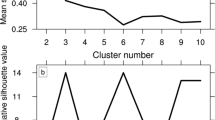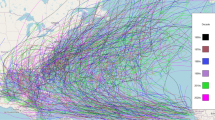Abstract
Tropical cyclones are one of the most serious natural disasters in northwestern Pacific Ocean. In general, an average of three to four typhoons invades the vicinity of Taiwan annually, which brings heavy rainfalls and strong winds resulting in disasters including flooding, mudflows, and landslides, leading to severe damage to economies and casualties. Studies show that different tracks of typhoon can cause distinct spatio-temporal patterns of rainfall events at different regions of Taiwan. As a result, understanding the trajectories of tropical cyclones and their relationship to climatic variables at global scale is crucial for hydrological modeling and disaster migration in Taiwan, especially under the conditions of climate change. This study applied a probabilistic curve clustering technique, which is based on a regression mixture model, to classify the best tracks of typhoons across the area within 6° around Taiwan during the period of 1951–2009. For the purposes of modeling and forecasting the typhoon trajectories, the track cluster is performed separately in different seasons due to their distinct driving forces to typhoon movements. A generalized linear model (GLM) is used to characterize the relationship between the identified typhoon tracks and the dominant climate features derived from NCEP reanalysis data. Results showed the six major typhoon tracks in the vicinity of Taiwan for different seasons respectively. The result of GLM cross validation showed that the frequency of typhoon tracks passing cross Taiwan in summer can significantly depend upon with two empirical orthogonal functions (EOFs) of sea level pressure, and the third EOF of sea surface temperature.







Similar content being viewed by others
References
Ali MM, Swain D, Kashyap T, McCreary JP, Nagamani PV (2013) Relationship between cyclone intensities and sea surface temperature in the Tropical Indian Ocean. IEEE Geosci Remote Sens Lett 10(4):841–844
Bilmes JA (1998) A gentle tutorial of the EM algorithm and its application to parameter estimation for Gaussian mixture and hidden Markov models. Int Comput Sci Inst 4(510):126
Camargo SJ, Robertson AW, Gaffney SJ, Smyth P, Ghil M (2007a) Cluster analysis of typhoon tracks. Part I: general properties. J Clim 20(14):3635–3653
Camargo SJ, Robertson AW, Gaffney SJ, Smyth P, Ghil M (2007b) Cluster analysis of typhoon tracks. Part II: large-scale circulation and ENSO. J Clim 20(14):3654–3676
Central Weather Bureau T (2014) Categorized paths of typhoons invading Taiwan? http://www.cwb.gov.tw/V7e/knowledge/encyclopedia/ty017.htm. Accessed 20 Jan 2014
Chan JCL (1985a) Identification of the steering flow for tropical cyclone motion from objectively analyzed wind fields. Mon Weather Rev 113(1):106–116
Chan JCL (1985b) Tropical cyclone activity in the northwest Pacific in relation to the El Niño/Southern Oscillation phenomenon. Mon Weather Rev 113(4):599–606
Chan JCL, Gray WM (1982) Tropical cyclone movement and surrounding flow relationships. Mon Weather Rev 110(10):1354–1374
Chiang SH, Chang KT (2011) The potential impact of climate change on typhoon-triggered landslides in Taiwan, 2010–2099. Geomorphology 133(3–4):143–151
Chu PS, Zhao X (2007) A Bayesian regression approach for predicting seasonal tropical cyclone activity over the central North Pacific. J Clim 20(15):4002–4013
Chu PS, Zhao X (2011) Bayesian analysis for extreme climatic events: a review. Atmos Res 102(3):243–262
Chu PS, Zhao X, Kim J-H (2010a) Regional typhoon activity as revealed by track patterns and climate change. In: Elsner JB, Hodges RE, Malmstadt JC, Scheitlin KN (eds) Hurricanes and climate change. Springer, Netherlands, pp 137–148
Chu PS, Zhao X, Ho CH, Kim HS, Lu MM, Kim JH (2010b) Bayesian forecasting of seasonal typhoon activity: a track-pattern-oriented categorization approach. J Clim 23(24):6654–6668
Chu PS, Chen DJ, Lin PL (2014) Trends in precipitation extremes during the typhoon season in Taiwan over the last 60 years. Atmos Sci Lett 15(1):37–43
Do CB, Batzoglou S (2008) What is the expectation maximization algorithm? Nat Biotechnol 26(8):897–899
Dobson AJ (1999) An introduction to generalized linear models. Chapman & Hall, Boca Raton
Elsner JB, Jagger TH (2004) A hierarchical Bayesian approach to seasonal hurricane modeling. J Clim 17(14):2813–2827
Elsner JB, Jagger TH (2006) Prediction models for annual US hurricane counts. J Clim 19(12):2935–2952
Elsner JB, Liu KB (2003) Examining the ENSO-typhoon hypothesis. Clim Res 25(1):43–54
Emanuel K (2005) Increasing destructiveness of tropical cyclones over the past 30 years. Nature 436(7051):686–688
Filho I G C (2008). Mixture models for the analysis of gene expression: integration of multiple experiments and cluster validation. Doctoral dissertation, Freie Universität Berlin
Fogarty EA, Elsner JB, Jagger TH, Liu KB, Louie KS (2006) Variations in typhoon landfalls over China. Adv Atmos Sci 23(5):665–677
Fox J (2008) Applied regression analysis and generalized linear models. SAGE, Los Angeles
Gaffney SJ (2004) Probabilistic curve-aligned clustering and prediction with regression mixture models. University of California, Irvine
Gaffney SJ, Robertson AW, Smyth P, Camargo SJ, Ghil M (2007) Probabilistic clustering of extratropical cyclones using regression mixture models. Clim Dyn 29(4):423–440
Gray WM, Landsea CW, Mielke PW, Berry KJ (1993) Predicting Atlantic basin seasonal tropical cyclone activity by 1-August. Weather Forecast 8(1):73–86
Gray WM, Landsea CW, Mielke PW, Berry KJ (1994) Predicting Atlantic basin seasonal tropical cyclone activity by 1 June. Weather Forecast 9(1):103–115
Hannachi A, Jolliffe IT, Stephenson DB (2007) Empirical orthogonal functions and related techniques in atmospheric science: a review. Int J Climatol 27(9):1119–1152
Hodanish S, Gray WM (1993) An observational analysis of tropical cyclone recurvature. Mon Weather Rev 121(10):2665–2689
Holland GJ (1995) Scale interaction in the western Pacific monsoon. Meteorol Atmos Phys 56(1–2):57–79
Hotelling H (1933) Analysis of a complex of statistical variables into principal components. J Educ Psychol 24:417–441
Hsu PC, Chu PS, Murakami H, Zhao X (2014) An abrupt decrease in the late-season typhoon activity over the western north Pacific. J Clim 27(11):4296–4312
Huang J-C, Yu C-K, Lee J-Y, Cheng L-W, Lee T-Y, Kao S-J (2012) Linking typhoon tracks and spatial rainfall patterns for improving flood lead time predictions over a mesoscale mountainous watershed. Water Resour Res 48(9):W09540
Japan Meteorological Agency J (2014). International Centers Operated by JMA. http://www.jma.go.jp/jma/en/Activities/intcorp.html. Accessed 20 Jan 2014
Kalnay E, Kanamitsu M, Kistler R, Collins W, Deaven D, Gandin L, Iredell M, Saha S, White G, Woollen J, Zhu Y, Chelliah M, Ebisuzaki W, Higgins W, Janowiak J, Mo KC, Ropelewski C, Wang J, Leetmaa A, Reynolds R, Jenne R, Joseph D (1996) The NCEP/NCAR 40-year reanalysis project. Bull Am Meteorol Soc 77(3):437–471
Kim HS, Kim JH, Ho CH, Chu PS (2011) Pattern classification of typhoon tracks using the fuzzy c-means clustering method. J Clim 24(2):488–508
Kim JH, Ho CH, Kim HS, Choi W (2012) 2010 western north Pacific typhoon season: seasonal overview and forecast using a track-pattern-based model. Weather Forecast 27(3):730–743
Lander MA (1996) Specific tropical cyclone track types and unusual tropical cyclone motions associated with a reverse-oriented monsoon trough in the western north Pacific. Weather Forecast 11(2):170–186
Lee CS, Huang LR, Shen HS, Wang ST (2006) A climatology model for forecasting typhoon rainfall in Taiwan. Nat Hazards 37(1–2):87–105
Lee YH, Yang HD, Chen CS (2012) Spatial risk assessment of typhoon cumulated rainfall: a case study in Taipei area. Stoch Environ Res Risk Assess 26(4):509–517
Lin YL, Ensley DB, Chiao S, Huang CY (2002) Orographic influences on rainfall and track deflection associated with the passage of a tropical cyclone. Mon Weather Rev 130(12):2929–2950
Lu MM, Chu PS, Lin YC (2010) Seasonal prediction of tropical cyclone activity near Taiwan using the Bayesian multivariate regression method. Weather Forecast 25(6):1780–1795
Lu MM, Lee CT, Wang B (2013) Seasonal prediction of accumulated tropical cyclone kinetic energy around Taiwan and the sources of the predictability. Int J Climatol 33(13):2846–2854
McCullagh P, Nelder JA (1989) Generalized linear models. Chapman and Hall, London
Mestre O, Hallegatte S (2009) Predictors of tropical cyclone numbers and extreme hurricane intensities over the north Atlantic using generalized additive and linear models. J Clim 22(3):633–648
Michaels PJ, Knappenberger PC, Davis RE (2006) Sea-surface temperatures and tropical cyclones in the Atlantic basin. Geophys Res Lett 33(9):L09708
Nakamura J, Lall U, Kushnir Y, Camargo SJ (2009) Classifying north Atlantic tropical cyclone tracks by mass moments. J Clim 22(20):5481–5494
Paliwal M, Patwardhan A (2013) Identification of clusters in tropical cyclone tracks of North Indian Ocean. Nat Hazards 68(2):645–656
Pan TY, Yang YT, Kuo HC, Tan YC, Lai JS, Chang TJ, Lee CS, Hsu KH (2011) Improvement of statistical typhoon rainfall forecasting with ANN-based southwest monsoon enhancement. Terr Atmos Ocean Sci 22(6):633–645
Pearson K (1901) On lines and planes of closest fit to systems of points in space. Philos Mag 2(7–12):559–572
Rasmusson EM, Carpenter TH (1982) Variations in tropical sea-surface temperature and surface wind fields associated with the Southern Oscillation El-Nino. Mon Weather Rev 110(5):354–384
Rogers JC (1997) North Atlantic storm track variability and its association to the north Atlantic oscillation and climate variability of northern Europe. J Clim 10(7):1635–1647
Simpson J, Ritchie E, Holland GJ, Halverson J, Stewart S (1997) Mesoscale interactions in tropical cyclone genesis. Mon Weather Rev 125(10):2643–2661
Smith TM, Reynolds RW, Peterson TC, Lawrimore J (2008) Improvements to NOAA’s historical merged land-ocean surface temperature analysis (1880–2006). J Clim 21(10):2283–2296
Trenberth K (2005) Uncertainty in hurricanes and global warming. Science 308(5729):1753–1754
Velden CS, Leslie LM (1991) The basic relationship between tropical cyclone intensity and the depth of the environmental steering layer in the Australian region. Weather Forecast 6(2):244–253
Vickery PJ, Skerlj PF, Steckley AC, Twisdale LA (2000) Hurricane wind field model for use in hurricane simulations. J Struct Eng-Asce 126(10):1203–1221
Wu CC, Kuo YH (1999) Typhoons affecting Taiwan: current understanding and future challenges. Bull Am Meteorol Soc 80(1):67–80
Wu CC, Yen TH, Kuo YH, Wang W (2002) Rainfall simulation associated with typhoon herb (1996) near Taiwan. Part I: the topographic effect. Weather Forecast 17(5):1001–1015
Yeh TC, Elsberry RL (1993a) Interaction of typhoons with the Taiwan orography. Part 1: upstream track deflections. Mon Weather Rev 121(12):3193–3212
Yeh TC, Elsberry RL (1993b) Interaction of typhoons with the Taiwan orography. Part 2: continuous and discontinuous tracks across the Island. Mon Weather Rev 121(12):3213–3233
Yu H-L, Chu H-J (2010) Understanding space–time patterns of groundwater system by empirical orthogonal functions: a case study in the Choshui River alluvial fan, Taiwan. J Hydrol 381(3–4):239–247
Yu H-L, Chu H-J (2012) Recharge signal identification based on groundwater level observations. Environ Monit Assess 184(10):5971–5982
Yu H-L, Chen B-L, Chiu C-H, Lu M-M, Tung C-P (2014) Analysis of space–time patterns of rainfall events during 1996–2008 in Yilan County (Taiwan). Stoch Environ Res Risk Assess. doi:10.1007/s00477-014-0928-x
Acknowledgments
Data in this study were provided by NOAA/OAR/ESRL PSD, National Centers for Environmental Prediction (NCEP), and Japan Meteorological Agency (JMA). The MATLAB Curve Clustering Toolbox (CCtoolbox) was provided by Scott Gaffney. This study was supported by funds from Taiwan National Science Council (NSC 101-2628-E-002-017-MY3 and NSC 102-2221-E-002-140-MY3), and Central Weather Bureau in Taiwan.
Author information
Authors and Affiliations
Corresponding author
Rights and permissions
About this article
Cite this article
Lin, YC., Chang, TJ., Lu, MM. et al. A space-time typhoon trajectories analysis in the vicinity of Taiwan. Stoch Environ Res Risk Assess 29, 1857–1866 (2015). https://doi.org/10.1007/s00477-014-1001-5
Published:
Issue Date:
DOI: https://doi.org/10.1007/s00477-014-1001-5




